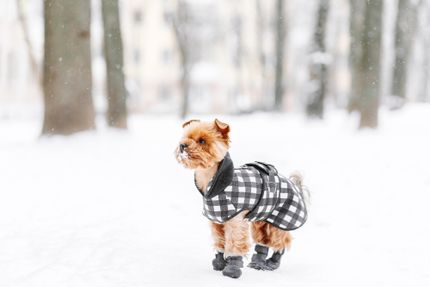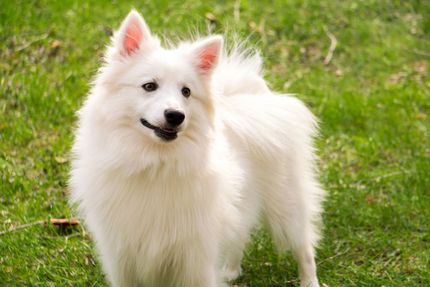
Westiepoo:West Highland White Terrier and Miniature Poodle Mix
Westiepoo
Facts & Origin
Profile of the Westiepoo
- Origin: America
- Breed: Registered as a designer dog, not FCI recognized
- Use: domestic dog, family dog
- Life expectancy: around 15 years
- Characteristics: playful, loyal and loving
What is the origin of the Westiepoo?
The Westiepoo was probably first bred in America in the 1970s. These dogs were bred as a cross between West Highland Terrier and Toy Poodle. The intention was to combine the positive characteristics of both breeds.
What are the breed characteristics of the Westiepoo?
If you want to buy a Westiepoo, then you should be aware that this is a so-called designer dog that was bred from the crossing of two breeds. As a result, the characteristics of both parent dogs can come through differently in every dog.
In general, however, Westiepoos are considered very intelligent, loving and loyal. If the Westies genes prevail, a certain hunting instinct cannot be denied. Westiepoo puppies can be stubborn, but they are usually easy to train since they are able to learn quickly.
When buying a Westiepoo, you can expect a playful dog that wants to build a close relationship with its family, but is not intrusive to strangers.

| Alternate Name | - |
| Origin | Scotland - Germany |
| Life expectancy | 14 - 15 years |
| Care requirements | high-maintenance - low-maintenance |
| Activity level | average |
| FCI group | not recognised |
| AKC group | not recognised |
| KC group | not recognised |
More West Highland White Terrier mixes
More Miniature Poodle mixes
Attitude, character and temperament of the breed
What are the typical character traits of Westiepoos?
In order to accurately predict the character of the Westiepoo, you have to trust the word of your Westiepoo breeder. The Westiepoo breeder should provide detailed information about the characteristics of the mated parents.
In general, Westiepoo puppies are very confident, they have a high urge to move while at the same time loving to cuddle. It is important that Westiepoos are well socialised from puppy age on. This dog might be small but nonetheless can be considered a proper dog.
Character
Usage

Health and breeding information
What are typical diseases of the Westiepoo?
Westiepoos tend to get heart problems when overexercising a lot. Skin problems can also occur with this breed. Whit Westiepoos, as with all small dog breeds, it is important that you focus on good dental care and nutrition. Westiepoos love to eat and tend to become overweight.
What should be considered when breeding Westiepoos?
If you want to buy a Westiepoo puppy, you should focus on finding a trustworthy breeder who only uses healthy and pure-bred dogs for further breeding. When mating, it is also important that the mother dog is bigger than the father and that the pregnancy and birth are monitored by a veterinarian. As with all small dog breeds, complications can arise at birth that could require the performance of a Caesarean Section. Therefore, the breeding of this dog should be in the hands of a well-experienced breeder that has the right know-how.


Appearance and coat of the Westiepoo
Their coat can be of short to medium length. Most Westiepoos steal your attention with a very fluffy appearance. The fur is slightly wavy and very soft. The colours of their fur can range from white, tan, brown to black. Westiepoos are one of the types of dogs that shed very small amounts of hair, yet grooming is a bit more complex. They have to be brushed regularly and their fur and hairs on their ears require a dog groomer from time to time.
What is the average size of a Westiepoo?
The size, of course, depends strongly on the parent dogs. A Westiepoo usually reaches about 25 to 43 cm in size.
How much does a Westiepoo weigh?
Here, too, the weight of the mated parents is decisive. On average, Westiepoos weigh between 6 kg and 14 kg.
What is the life expectancy of a Westiepoo?
The average age of these dogs is around 15 years. Of course, this depends a lot on how they are kept. Healthy, well-nourished dogs that are given enough exercise and good veterinary care can reach a higher age.
| Fur length | medium |
| Fur | flat coated - curly |
| Ear shape | Standing Ears - Floppy Ear |
| Tail | short - lang |
| Anatomy | square, hefty |
| Size ♀ | 25 - 43 cm |
| Weight ♀ | 6 - 14 kg |
| Size ♂ | 25 - 43 cm |
| Weight ♂ | 6 - 14 kg |
| Suitable For | Beginner, Children, Seniors |
Colors



Known Diseases
Denture malocclusions
Malocclusions of the dentition often occur in dogs with short muzzles.
Patellar problems
Problems with the Patellar can be a displacement or weak kneecap, which is one of the most common causes of lameness in dogs, also because of overweight.
Tartar
If dogs don't get a good food or sugary food, tartar can quickly appear.
Eye diseases
Often occur with allergies and intolerances.
Epilepsy
Definition: Dog has epilepsy if, for example, at least two epileptic seizures occur more than 24 hours apart.
Cataract
Cataracts are still one of the most common causes of blindness, even in dogs.
Patellar luxation
Patellar luxation is the term used to describe a displacement of the kneecap, which is one of the most common causes of lameness in dogs.
Progressive Retinal Atrophy (PRA)
Progressive retinal atrophy (PRA) is a slowly progressive death of the retina in dogs.
Ureteral ectopy
Ureteral ectopy (also known as ureteral ectopia) is an inherited condition where the ureter (known as the ureter) does not end in the bladder as usual due to a misalignment.
FAQ
-
The Westiepoo was first bred probably in America in the 1970-ies. These dogs were bred from the breeds Westhighland Terrier and Miniature Poodle. The reason for this was to combine the positive characteristics of both breeds.
-
On average, an age of 15 years can be expected. It depends on the health, gene pool, exercise and diet of the animal.
-
After approx. 2 years a Westiepoo is fully grown. After about 1 year you can see the final height of the animal.
Useful Articles
You can find articles that might interest you in the dogbible blog to match your favorite breed.
Visit our magazineto stay up to date on dog trends.
To find out more, view our Privacy Policy
Find here the breed that suits you and find out what character traits it has. Here you can also learn more about the origin, size and weight of your favorite breeds.
Matching your favorite breed, you'll find articles that might interest you on the dogbible dog blog.
5 beautiful dog places in Mallorca
How many dog breeds are there - 2021! The current number


















